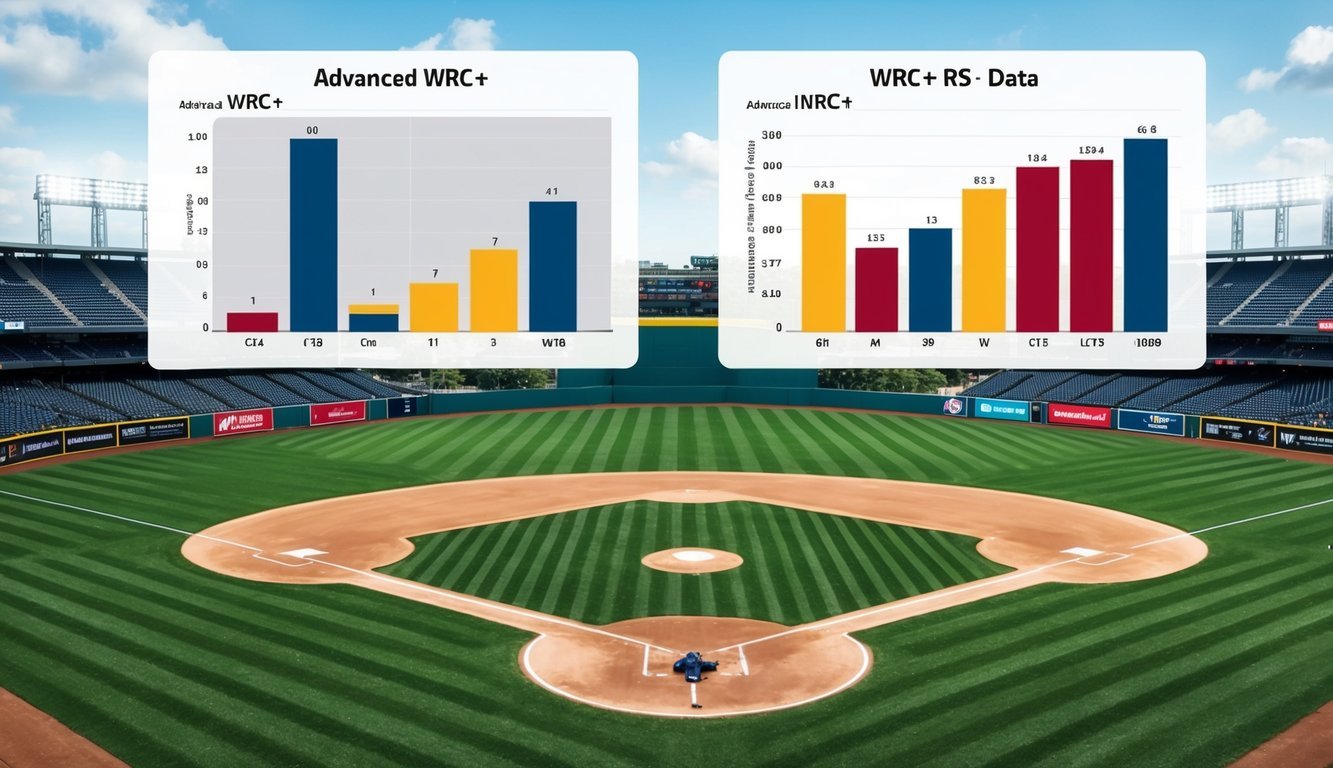Baseball enthusiasts are always looking for new ways to measure player performance.
One statistic that has gained popularity in recent years is Weighted Runs Created Plus, or wRC+.
This advanced metric aims to quantify a player’s offensive contribution more accurately than traditional stats.
wRC+ measures how many runs a player creates compared to the league average, adjusting for factors like ballpark and era. A wRC+ of 100 represents a league-average hitter, while values above 100 indicate above-average performance.
For example, a player with a wRC+ of 120 is creating 20% more runs than the average player.
This statistic offers a comprehensive view of a batter’s offensive output, taking into account various aspects of their performance at the plate.
By considering external factors, wRC+ provides a more nuanced evaluation of a player’s true offensive value to their team.
Explaining Weighted Runs Created (WRC)
Weighted Runs Created (WRC) offers a comprehensive way to measure a player’s offensive contributions in baseball.
This advanced metric provides valuable insights into run production and offensive value.
The Concept of WRC and its Importance in Baseball
WRC builds upon Bill James’ original Runs Created statistic, aiming to quantify a player’s total offensive value in terms of runs.
Instead of presenting individual stats like doubles, home runs, and walks separately, WRC synthesizes this information into a single number.
This metric allows for easier player comparisons and provides a clearer picture of offensive production.
WRC considers various offensive actions, giving appropriate weight to each based on their impact on run scoring.
Understanding the WRC Formula and Calculation
The WRC formula incorporates several offensive statistics to calculate a player’s run creation value.
These include hits, walks, hit by pitches, and total bases, among others.
Each offensive action is assigned a specific weight based on its relative importance in producing runs.
For example, a home run is weighted more heavily than a single.
To calculate WRC, these weighted values are combined using a formula that considers league averages and park factors.
This adjustment helps account for different playing environments and ensures fair player comparisons across various contexts.
The resulting number represents the estimated number of runs a player has created through their offensive contributions.
Analyzing WRC+ and Its Advantages
WRC+ provides a comprehensive measure of a batter’s offensive value, accounting for various factors that influence performance.
This advanced metric offers insights beyond traditional statistics, allowing for fair comparisons across different contexts.
WRC+ Versus Traditional Metrics
WRC+ surpasses conventional batting statistics by offering a more holistic view of a player’s offensive contributions.
Unlike batting average or RBIs, WRC+ considers the full spectrum of offensive outcomes.
It weights each type of hit based on its run-producing value, giving more credit for extra-base hits than singles.
WRC+ also incorporates on-base percentage, reflecting a player’s ability to avoid outs.
This comprehensive approach provides a clearer picture of a batter’s overall offensive impact.
For example, a player with a high WRC+ might have a lower batting average but contribute more to run production through walks and extra-base hits.
The Role of Ballparks and Era Adjustments in WRC+
One of WRC+’s key strengths is its ability to normalize performance across different ballparks and eras.
This adjustment is crucial in baseball, where park effects can significantly influence offensive numbers.
Coors Field in Colorado, known for its hitter-friendly environment, is a prime example.
WRC+ accounts for these variations by incorporating park factors into its calculations.
It also considers league-wide offensive trends, allowing for fair comparisons between players from different eras.
This normalization ensures that a player’s WRC+ value accurately reflects their performance relative to their peers, regardless of where or when they played.
Impact of WRC and WRC+ on Player Evaluations

WRC and WRC+ have revolutionized how players are evaluated in baseball.
These stats provide a more comprehensive view of offensive production compared to traditional metrics.
Comparing Players Across Eras with WRC and WRC+
WRC+ allows for fair comparisons of players from different time periods.
It accounts for league-wide offensive trends and ballpark effects, making it easier to assess talent across generations.
A player with a WRC+ of 120 in the 1960s can be directly compared to a player with the same WRC+ today.
This stat helps front offices and fans understand how stars like Mike Trout stack up against legends from the past.
WRC+ also illuminates the true value of players who may have been underappreciated in their era due to lower batting averages or home run totals.
Understanding Positional and League Adjustments
WRC and WRC+ factor in positional and league adjustments, providing context to a player’s offensive contributions.
This is crucial for evaluating players at different positions and in different leagues.
For example, a shortstop with a WRC+ of 110 might be more valuable than a first baseman with the same score.
The stat accounts for the typically lower offensive output expected from middle infielders.
These adjustments also help in draft evaluations and trade analyses.
Teams can better assess how a player’s production might translate when moving between leagues or ballparks.
WRC+ makes it easier to spot undervalued players who may not shine in traditional stats but contribute significantly to their team’s run production.
Advanced Statistics Derived from WRC and WRC+

WRC and WRC+ serve as foundational metrics for several other advanced baseball statistics.
These derived measures provide deeper insights into player performance and value.
By analyzing WRC and WRC+, teams can identify players who excel under pressure or in clutch situations, further enhancing their strategic decision-making.
Additionally, understanding these metrics allows coaches to implement baseball mental toughness techniques, helping athletes improve their focus and resilience on the field.
As a result, teams not only evaluate current performance but also foster player development that aligns with long-term success.
The Relationship Between OBP, SLG, and WOBA in WRC Calculations
On-base percentage (OBP), slugging percentage (SLG), and weighted on-base average (WOBA) play crucial roles in WRC calculations.
OBP measures a player’s ability to reach base, while SLG reflects power hitting.
WOBA combines these aspects, assigning values to different offensive outcomes.
WOBA forms the basis for WRC, incorporating:
- Singles
- Doubles
- Triples
- Home runs
- Walks
- Hit by pitches
Each event is weighted based on its run value.
For example, a home run contributes more to WOBA than a single.
This comprehensive approach allows WRC to capture a player’s overall offensive contribution more accurately than traditional stats like RBIs or hits alone.
How WAR and WRAA Relate to WRC+
Wins Above Replacement (WAR) and Weighted Runs Above Average (WRAA) are closely tied to WRC+.
WAR aims to quantify a player’s total value, including offense, defense, and baserunning.
The offensive component of WAR often relies on WRC+ as a key input.
WRAA measures how many runs a player contributes above or below league average.
It’s calculated using WRC and league WRC per plate appearance.
WRAA per PA provides a rate stat for comparing players with different playing time.
WRC+ adjusts for ballpark effects and league averages, making it ideal for these comparisons.
A player with a 120 WRC+ is creating 20% more runs than league average, directly impacting their WRAA and WAR values.
By incorporating these metrics, teams can better evaluate player performance and make informed roster decisions.
Case Studies and Historical Context

Weighted Runs Created (WRC) and its park-adjusted counterpart WRC+ have become crucial metrics for evaluating offensive performance in baseball.
These statistics provide valuable insights into player contributions across different eras and ballparks.
In-Depth Analysis of Famous Players’ WRC and WRC+ Scores
Ted Williams stands out as one of the greatest hitters in baseball history, with an incredible career WRC+ of 188.
This means he created 88% more runs than the average player of his era.
In recent years, young stars like Fernando Tatis Jr. and Vladimir Guerrero Jr. have also posted impressive WRC+ scores early in their careers.
Jesse Winker’s 2021 season showcased the importance of WRC+.
Despite playing in a hitter-friendly park, his park-adjusted 148 WRC+ highlighted his true offensive value.
This statistic accounts for factors like home runs and slugging percentage while considering park effects.
The Evolution of Run Creation Metrics and Their Adoption
Bill James introduced the original Runs Created statistic, paving the way for more advanced metrics.
WRC and WRC+ built upon this foundation, offering more precise evaluations of offensive contributions.
These stats quickly gained popularity among statisticians and fans alike.
WRC+ incorporates adjustments for league and park factors, allowing for fairer comparisons across different eras and environments.
It quantifies a player’s total offensive value, considering power, on-base skills, and overall production.
Many now prefer WRC+ to traditional stats like OPS+ for its comprehensive nature.
The adoption of WRC and WRC+ has transformed how teams and fans analyze hitting performance.
These metrics provide a more nuanced understanding of offensive value, moving beyond simple counting stats like home runs.
